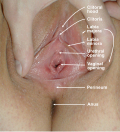Female reproductive system
Female reproductive system is a complex system in the female body that plays a crucial role in reproduction. It includes various organs and structures such as the ovaries, fallopian tubes, uterus, vagina, and vulva.
Anatomy[edit]
The female reproductive system is made up of internal and external structures. The internal structures include the ovaries, fallopian tubes, uterus, and vagina. The external structures include the vulva, which consists of the labia majora, labia minora, clitoris, and vaginal opening.
Ovaries[edit]
The ovaries are a pair of small, almond-shaped organs located on either side of the uterus. They are responsible for producing eggs (or oocytes) and the female hormones estrogen and progesterone.
Fallopian Tubes[edit]
The fallopian tubes are a pair of tubes that connect the ovaries to the uterus. They are the site where fertilization usually occurs.
Uterus[edit]
The uterus, also known as the womb, is a pear-shaped organ located in the lower abdomen. It is where the fetus develops during pregnancy.
Vagina[edit]
The vagina is a muscular canal that extends from the cervix, which is the lower part of the uterus, to the external part of the female genitalia, which is called the vulva.
Function[edit]
The main function of the female reproductive system is to produce eggs for fertilization and to provide a place where a fertilized egg can develop into a fetus. The ovaries produce the female eggs or oocytes. If an oocyte is fertilized by a sperm, it will move into the uterus and implant itself into the uterine wall, where it will develop into a fetus.
Diseases and Conditions[edit]
There are many diseases and conditions that can affect the female reproductive system. These include, but are not limited to, endometriosis, polycystic ovary syndrome, uterine fibroids, and various forms of gynecological cancer.
See Also[edit]
|
|
|
-
Lateral view of the female reproductive system
-
Diagram of the female reproductive system with numbered labels
-
Female reproductive system
-
Diagram showing the vaginal opening
-
Illustration of the female reproductive system
-
Diagram of the female reproductive system
Ad. Transform your life with W8MD's Budget GLP-1 injections from $75


W8MD offers a medical weight loss program to lose weight in Philadelphia. Our physician-supervised medical weight loss provides:
- Weight loss injections in NYC (generic and brand names):
- Zepbound / Mounjaro, Wegovy / Ozempic, Saxenda
- Most insurances accepted or discounted self-pay rates. We will obtain insurance prior authorizations if needed.
- Generic GLP1 weight loss injections from $75 for the starting dose.
- Also offer prescription weight loss medications including Phentermine, Qsymia, Diethylpropion, Contrave etc.
NYC weight loss doctor appointmentsNYC weight loss doctor appointments
Start your NYC weight loss journey today at our NYC medical weight loss and Philadelphia medical weight loss clinics.
- Call 718-946-5500 to lose weight in NYC or for medical weight loss in Philadelphia 215-676-2334.
- Tags:NYC medical weight loss, Philadelphia lose weight Zepbound NYC, Budget GLP1 weight loss injections, Wegovy Philadelphia, Wegovy NYC, Philadelphia medical weight loss, Brookly weight loss and Wegovy NYC
|
WikiMD's Wellness Encyclopedia |
| Let Food Be Thy Medicine Medicine Thy Food - Hippocrates |
Medical Disclaimer: WikiMD is not a substitute for professional medical advice. The information on WikiMD is provided as an information resource only, may be incorrect, outdated or misleading, and is not to be used or relied on for any diagnostic or treatment purposes. Please consult your health care provider before making any healthcare decisions or for guidance about a specific medical condition. WikiMD expressly disclaims responsibility, and shall have no liability, for any damages, loss, injury, or liability whatsoever suffered as a result of your reliance on the information contained in this site. By visiting this site you agree to the foregoing terms and conditions, which may from time to time be changed or supplemented by WikiMD. If you do not agree to the foregoing terms and conditions, you should not enter or use this site. See full disclaimer.
Credits:Most images are courtesy of Wikimedia commons, and templates, categories Wikipedia, licensed under CC BY SA or similar.
Translate this page: - East Asian
中文,
日本,
한국어,
South Asian
हिन्दी,
தமிழ்,
తెలుగు,
Urdu,
ಕನ್ನಡ,
Southeast Asian
Indonesian,
Vietnamese,
Thai,
မြန်မာဘာသာ,
বাংলা
European
español,
Deutsch,
français,
Greek,
português do Brasil,
polski,
română,
русский,
Nederlands,
norsk,
svenska,
suomi,
Italian
Middle Eastern & African
عربى,
Turkish,
Persian,
Hebrew,
Afrikaans,
isiZulu,
Kiswahili,
Other
Bulgarian,
Hungarian,
Czech,
Swedish,
മലയാളം,
मराठी,
ਪੰਜਾਬੀ,
ગુજરાતી,
Portuguese,
Ukrainian








